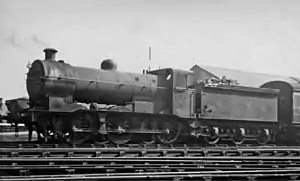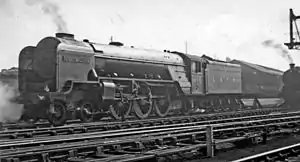Grantham railway station
Grantham railway station is on the East Coast Main Line in the United Kingdom, serving the town of Grantham, Lincolnshire. It is 105 miles 38 chains (169.7 km) down the line from London King's Cross and is situated on the main line between Peterborough to the south and Newark North Gate to the north.
 Southbound view of the station from Platform 2 in July 2012 | |
| Location | Grantham, District of South Kesteven England |
| Coordinates | 52.906°N 0.642°W |
| Grid reference | SK914351 |
| Managed by | London North Eastern Railway |
| Platforms | 4 |
| Other information | |
| Station code | GRA |
| Classification | DfT category C1 |
| History | |
| Opened | 1852 |
| Key dates | |
| 1906 | Grantham rail accident |
| 1988 | Main line electrification |
| 2006 | Allington Chord opened |
| Passengers | |
| 2015/16 | |
| 2016/17 | |
| 2017/18 | |
| 2018/19 | |
| 2019/20 | |
| Interchange | 0.271 million |
| Notes | |
Passenger statistics from the Office of Rail and Road | |
Two secondary lines diverge from the main line north of Grantham: the "Poacher Line" to Skegness and a branch line to Nottingham.
Its three-letter station code is GRA.
History
The original station at Grantham (Old Wharf) was opened when the Ambergate, Nottingham, Boston & Eastern Junction Railway opened its line from Nottingham on 15 July 1850.[1] This line was taken over by the Great Northern Railway in 1854. This was replaced by the present station which opened on 1 August 1852; the Old Wharf station closed the following day.[2]
The new station was on the GNR's direct line between Peterborough and Retford (the Towns Line), which was completed in 1852. The alternative route via Boston and Lincoln (the Fens Loop Line) had already opened in 1850. The Boston, Sleaford and Midland Counties Railway opened their line from Barkston Junction, 2 miles north of Grantham, to Sleaford in 1857, and on to Boston in 1859. This railway was taken over by the GNR in 1864. The Grantham to Lincoln line, which branched off the Sleaford line at Honington, was opened in 1867. Finally, the Great Northern and London and North Western Joint Railway was opened in 1879. This ran from Market Harborough and Leicester Belgrave Road in the south, through Melton Mowbray to Nottingham and Newark in the north, crossing the Grantham to Nottingham line near Bottesford. The GNR operated a Grantham to Leicester service via this route.
The early life of the station was marred by some unfortunate accidents. On 25 July 1868, William Collins, a GNR cleaner, was run over by a guard's van and killed.[3] On 4 November 1868, John Boswell, aged 80, was wandering along the line near the station when he was killed by a down train.[4] On 23 May 1873, Thomas Robinson, a GNR engine driver, was struck fatally by a ballast-engine whilst crossing the yard at the station.[5] On 12 March 1887, Eli Addlesee, a driver, was killed by some wagons being shunted in the station[6] On 27 November 1898, John William Frisby, a GNR shunter, was killed whilst crossing the line near the station.[7]
In 1937, the LNER announced that they planned to lengthen the down platform. At 800 feet (240 m) long it was too short to accommodate the increasing length of the main line express trains, and the work would extend it to 950 feet (290 m).[8] At the same time the whole platform length was to be raised to a standard height of 3 feet (0.91 m) and a new awning over the platform opposite the station buildings would be added.
Station Masters
- John James Ford 1867 - ????
- Mr. Bellamy 1878 - 1882[9]
- Charles William Wood 1882 - 1901
- Arthur Joseph Pott 1902 - 1912[10]
- Ernest Horatio Essame 1912 - 1917[11] (afterwards station master at Hull)
- William Bradley 1917[12] - 1925
- Harry Dennick 1925 - 1930
- C.J. Cooke 1930 - 1938
- Harold Gardner 1938 - 1943[13] (afterwards station master at London Marylebone)
- Harold Scampion 1947[14] - ????
Description
Junctions near the town also connect to branches to Nottingham, and to Sleaford and Skegness. The station was built close to the factory of Richard Hornsby & Sons.
It is composed of four platforms; platforms 1 and 2 are on the East Coast Main Line and are responsible for express services between London and Scotland. Platform 1 serves exclusively London King's Cross via Peterborough and Stevenage; Platform 2 serves cities of northern England and Edinburgh. Platform 2, 3 and 4 are formed from a large island platform structure. Platform 3 is a bay platform at the northern end of the station that is used to allow local trains to reverse, while Platform 4 is a two-way platform that is used by East Midlands Railway. Only Platform 1 has amenities, including toilets, refreshments and a buffet.
Prior to the reopening of the Allington Chord in 2006, trains for Nottingham – Grantham – Skegness reversed in the station and travelled along the ECML, crossing the ECML via a flat junction, adding to congestion on the main line. Since the opening of the chord they reverse and travel whence they came using the chord, crossing under the ECML using existing tracks.[15]
The journey to London King's Cross takes a little over an hour, with trains provided by London North Eastern Railway and Hull Trains
In May 2009 National Express East Coast installed ticket barriers. These have since been removed however.
Services



.jpg.webp)
| Preceding station | Historical railways | Following station | ||
|---|---|---|---|---|
| Great Ponton Line open, station closed |
Great Northern Railway East Coast main line |
Barkston Line open, station closed | ||
| Terminus | Great Northern Railway Grantham to Boston |
Barkston Line open, station closed | ||
| Terminus | Great Northern Railway Grantham to Lincoln |
Barkston Line open, station closed | ||
| Terminus | Great Northern Railway Grantham to Nottingham |
Sedgebrook Line open, station closed | ||
| Terminus | Great Northern Railway Grantham to Leicester Belgrave Road |
Sedgebrook Line open, station closed | ||
Accidents and incidents
- 7 July 1898. The 9.25pm up express from Manchester collided with a goods engine which was crossing from the up sidings to the down main line. Six passengers, the guard and both drivers were slightly injured.[16]
- 19 September 1906, a sleeper train was derailed after overrunning signals and passing through the station at excessive speed, fourteen people were killed and seventeen were injured.
References
- "Opening of the Ambergate Railway from Nottingham to Grantham". Nottinghamshire Guardian. England. 18 July 1850. Retrieved 28 June 2017 – via British Newspaper Archive.
- Butt, R.V.J. (1995). The Directory of Railway Stations. Yeovil: Patrick Stephens Ltd. p. 108. ISBN 1-85260-508-1. R508.
- "A Man Killed". Grantham Journal. England. 1 August 1868. Retrieved 28 June 2017 – via British Newspaper Archive.
- "Fatal Accident near the Grantham Station". Grantham Journal. England. 7 November 1868. Retrieved 28 June 2017 – via British Newspaper Archive.
- "Fatal Accident at Grantham Station". Grantham Journal. England. 24 May 1873. Retrieved 28 June 2017 – via British Newspaper Archive.
- "Shocking Railway Fatality at Grantham Station". Grantham Journal. England. 19 March 1887. Retrieved 28 June 2017 – via British Newspaper Archive.
- "Another Fatal Accident at Grantham Station". Grantham Journal. England. 3 December 1898. Retrieved 28 June 2017 – via British Newspaper Archive.
- "One of the longest island platforms". Grantham Journal. England. 23 October 1937. Retrieved 28 June 2017 – via British Newspaper Archive.
- "Death of Mr. Bellamy". Grantham Journal. England. 8 April 1882. Retrieved 2 September 2017 – via British Newspaper Archive.
- "Grantham Station Master Retires". Lincolnshire Standard and Boston Guardian. England. 20 July 1912. Retrieved 2 September 2017 – via British Newspaper Archive.
- "Station Master's New Appointment". Grantham Journal. England. 22 September 1917. Retrieved 2 September 2017 – via British Newspaper Archive.
- "Mr. William Bradley". Yorkshire Post and Leeds Intelligencer. England. 20 October 1917. Retrieved 2 September 2017 – via British Newspaper Archive.
- "Failure of a Mission". Yorkshire Evening Post. England. 23 December 1943. Retrieved 2 September 2017 – via British Newspaper Archive.
- "From Far and Near". Nottingham Journal. England. 14 June 1947. Retrieved 2 September 2017 – via British Newspaper Archive.
- "£12 MILLION NEW RAILWAY STRIKES HARMONIOUS CHORD FOR PASSENGERS". Network Rail. 13 October 2005. Retrieved 24 March 2016.
- "The Collision at Grantham Station". Lincolnshire Echol. England. 13 September 1898. Retrieved 28 June 2017 – via British Newspaper Archive.
- Whittaker, Nicholas (1995). "Chapter 4". Platform Souls. London: Gollancz.
External links
- Train times and station information for Grantham railway station from National Rail
- Pathe newsreel, 1947. Experimental snowplough at Grantham
| Wikimedia Commons has media related to Grantham railway station. |